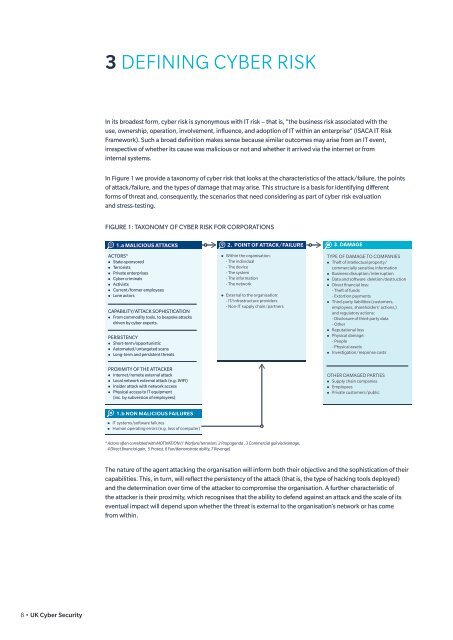k88nFi
k88nFi
k88nFi
You also want an ePaper? Increase the reach of your titles
YUMPU automatically turns print PDFs into web optimized ePapers that Google loves.
3 DEFINING CYBER RISKIn its broadest form, cyber risk is synonymous with IT risk – that is, “the business risk associated with theuse, ownership, operation, involvement, influence, and adoption of IT within an enterprise” (ISACA IT RiskFramework). Such a broad definition makes sense because similar outcomes may arise from an IT event,irrespective of whether its cause was malicious or not and whether it arrived via the internet or frominternal systems.In Figure 1 we provide a taxonomy of cyber risk that looks at the characteristics of the attack/failure, the pointsof attack/failure, and the types of damage that may arise. This structure is a basis for identifying differentforms of threat and, consequently, the scenarios that need considering as part of cyber risk evaluationand stress-testing.FIGURE 1: TAXONOMY OF CYBER RISK FOR CORPORATIONS1.a MALICIOUS ATTACKS 2. POINT OF ATTACK/FAILURE3. DAMAGEACTORS*• State-sponsored• Terrorists• Private enterprises• Cyber criminals• Activists• Current/former employees• Lone actorsCAPABILITY/ATTACK SOPHISTICATION• From commodity tools, to bespoke attacksdriven by cyber experts.PERSISTENCY• Short-term/opportunistic• Automated/untargeted scans• Long-term and persistent threats• Within the organisation:- The individual- The device- The system- The information- The network• External to the organisation:- IT/infrastructure providers- Non-IT supply chain/partnersTYPE OF DAMAGE TO COMPANIES• Theft of intellectual property/commercially sensitive information• Business disruption/interruption• Data and software deletion/destruction• Direct financial loss:- Theft of funds- Extortion payments• Third-party liabilities (customers,employees, shareholders’ actions,)and regulatory actions:- Disclosure of third-party data- Other• Reputational loss• Physical damage:- People- Physical assets• Investigation/response costsPROXIMITY OF THE ATTACKER• Internet/remote external attack• Local network external attack (e.g. WIFI)• Insider attack with network access• Physical access to IT equipment(inc. by subversion of employees)OTHER DAMAGED PARTIES• Supply chain companies• Employees• Private customers/public1.b NON MALICIOUS FAILURES• IT systems/software failures• Human operating errors (e.g. loss of computer)* Actors often correlated with MOTIVATION (1 Warfare/terrorism, 2 Propaganda , 3 Commercial gain/advantage,4 Direct financial gain, 5 Protest, 6 Fun/demonstrate ability, 7 Revenge).The nature of the agent attacking the organisation will inform both their objective and the sophistication of theircapabilities. This, in turn, will reflect the persistency of the attack (that is, the type of hacking tools deployed)and the determination over time of the attacker to compromise the organisation. A further characteristic ofthe attacker is their proximity, which recognises that the ability to defend against an attack and the scale of itseventual impact will depend upon whether the threat is external to the organisation’s network or has comefrom within.8 • UK Cyber Security


